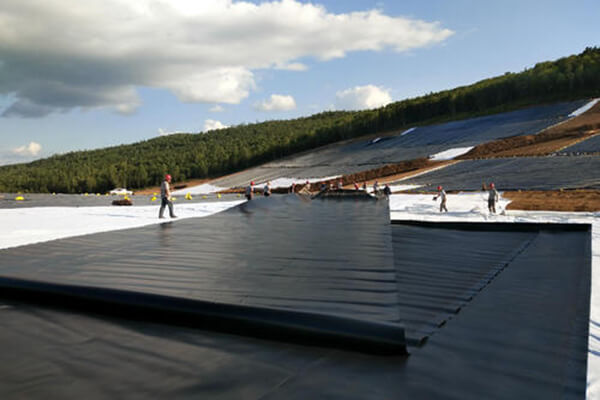Precautions before laying composite geomembrane
Before laying the composite geomembrane, in order to ensure the smooth progress of the geomembrane laying, minimize wrinkles, cutting, and material waste, avoid cross joints and ensure that the distance between the transverse welds of two adjacent layers of geomembrane is greater than 1m. Draw a schematic diagram of geomembrane laying based on topography, slope, and geomembrane width, including a selection of high-quality environmental geomembrane laying width and weld location design.
The composite geomembrane of this project is spliced by hot-melt welding, and the welding equipment uses an 800 geomembrane welding machine and a hand-held hot air welding gun. Before each laying and welding, adjust the temperature state of the welding equipment according to the prevailing climatic conditions and film thickness, conduct a small sample welding test on-site, and try to weld 1m long geomembrane samples. Ensure that the welding machine works under the appropriate welding temperature, walking speed, and other parameters to ensure welding quality.

The geomembrane on the right bank slope is laid in two parts, the elevation is 595 meters. First, lay the upper part. Before laying, the anchor ditch should be treated to remove loose stones and debris at the bottom of the ditch and level it. According to the design requirements, the length of the upper end of the geomembrane buried in the anchoring groove is 1.2m, and it is required to be close to the inside of the anchoring groove with sufficient clearance. After laying and welding, backfill with clean water to the design elevation, and tamped with a small rammer.
When laying composite geomembrane produced by LDPE geomembrane manufacturers on slopes, it should be constructed in rain-free weather and laid manually in blocks according to the flow operation sequence, with a length of 30m each time. Rolling along the slope from top to bottom, the laying should be naturally relaxed, should not be pulled too tightly, and there should be enough clearance to meet the deformation requirements. In order to ensure the overall quality of the waterproof layer and avoid the formation of cross joints, the operator should wear flat shoes or soft rubber shoes when laying; if the geomembrane is found damaged during the construction process, it should be repaired in time.
